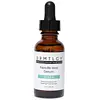What's inside
What's inside
 Key Ingredients
Key Ingredients

 Benefits
Benefits

 Concerns
Concerns

No concerns
 Ingredients Side-by-side
Ingredients Side-by-side

Water
Skin ConditioningGlycerin
HumectantNiacinamide
SmoothingSodium Chondroitin Sulfate
Skin ConditioningMethylglucoside Phosphate
Skin ConditioningCopper Lysinate/Prolinate
Skin ConditioningGlycosaminoglycans
EmollientBambusa Vulgaris Leaf/Stem Extract
HumectantPisum Sativum Extract
Skin ConditioningGlucosamine Hcl
Sodium Hyaluronate
HumectantPanthenol
Skin ConditioningPhenoxyethanol
PreservativeEthylhexylglycerin
Skin ConditioningPolysorbate 20
EmulsifyingDisodium EDTA
Water, Glycerin, Niacinamide, Sodium Chondroitin Sulfate, Methylglucoside Phosphate, Copper Lysinate/Prolinate, Glycosaminoglycans, Bambusa Vulgaris Leaf/Stem Extract, Pisum Sativum Extract, Glucosamine Hcl, Sodium Hyaluronate, Panthenol, Phenoxyethanol, Ethylhexylglycerin, Polysorbate 20, Disodium EDTA
Water
Skin ConditioningGlycolic Acid
BufferingNeopentyl Glycol Dicaprylate/Dicaprate
EmollientGlycerin
HumectantCyclopentasiloxane
EmollientGlyceryl Stearate
EmollientPEG-100 Stearate
Stearic Acid
CleansingSodium Acrylate/Sodium Acryloyldimethyl Taurate Copolymer
Emulsion StabilisingSodium Hydroxide
BufferingCaprylic/Capric Triglyceride
MaskingCetyl Alcohol
EmollientDimethicone
EmollientCetearyl Alcohol
EmollientIsohexadecane
EmollientSqualane
EmollientEthylhexyl Palmitate
EmollientPersea Gratissima Oil
Skin ConditioningOryza Sativa Bran Oil
EmollientButyrospermum Parkii Butter
Skin ConditioningSorbitol
HumectantPhenoxyethanol
PreservativeEucalyptus Globulus Leaf Oil
PerfumingSorbitan Stearate
EmulsifyingXanthan Gum
EmulsifyingPolysorbate 80
EmulsifyingPolysorbate 60
EmulsifyingPrunus Amygdalus Dulcis Oil
Skin ConditioningVegetable Oil
Skin ConditioningCaprylyl Glycol
EmollientMagnesium Aluminum Silicate
AbsorbentTocopheryl Acetate
AntioxidantSorbitan Oleate
EmulsifyingDipotassium Glycyrrhizate
HumectantEthylhexylglycerin
Skin ConditioningHexylene Glycol
EmulsifyingGlycine Soja Sterols
EmollientLinoleic Acid
CleansingPhospholipids
Skin ConditioningPolysorbate 20
EmulsifyingRetinol
Skin ConditioningLactic Acid
BufferingCetyl Palmitate
EmollientLaureth-23
CleansingCucumis Sativus Fruit Extract
EmollientLimonene
PerfumingTetrasodium Glutamate Diacetate
Hamamelis Virginiana Leaf Extract
Skin ConditioningCeramide NP
Skin ConditioningTrideceth-6 Phosphate
EmulsifyingPotassium Bitartrate
BufferingTitanium Dioxide
Cosmetic ColorantSodium Hyaluronate
HumectantTocopherol
AntioxidantBHT
AntioxidantPalmitic Acid
EmollientBHA
AntioxidantQuartz
AbrasiveAscorbic Acid
AntioxidantWater, Glycolic Acid, Neopentyl Glycol Dicaprylate/Dicaprate, Glycerin, Cyclopentasiloxane, Glyceryl Stearate, PEG-100 Stearate, Stearic Acid, Sodium Acrylate/Sodium Acryloyldimethyl Taurate Copolymer, Sodium Hydroxide, Caprylic/Capric Triglyceride, Cetyl Alcohol, Dimethicone, Cetearyl Alcohol, Isohexadecane, Squalane, Ethylhexyl Palmitate, Persea Gratissima Oil, Oryza Sativa Bran Oil, Butyrospermum Parkii Butter, Sorbitol, Phenoxyethanol, Eucalyptus Globulus Leaf Oil, Sorbitan Stearate, Xanthan Gum, Polysorbate 80, Polysorbate 60, Prunus Amygdalus Dulcis Oil, Vegetable Oil, Caprylyl Glycol, Magnesium Aluminum Silicate, Tocopheryl Acetate, Sorbitan Oleate, Dipotassium Glycyrrhizate, Ethylhexylglycerin, Hexylene Glycol, Glycine Soja Sterols, Linoleic Acid, Phospholipids, Polysorbate 20, Retinol, Lactic Acid, Cetyl Palmitate, Laureth-23, Cucumis Sativus Fruit Extract, Limonene, Tetrasodium Glutamate Diacetate, Hamamelis Virginiana Leaf Extract, Ceramide NP, Trideceth-6 Phosphate, Potassium Bitartrate, Titanium Dioxide, Sodium Hyaluronate, Tocopherol, BHT, Palmitic Acid, BHA, Quartz, Ascorbic Acid
 Reviews
Reviews

Ingredients Explained
These ingredients are found in both products.
Ingredients higher up in an ingredient list are typically present in a larger amount.
Ethylhexylglycerin (we can't pronounce this either) is commonly used as a preservative and skin softener. It is derived from glyceryl.
You might see Ethylhexylglycerin often paired with other preservatives such as phenoxyethanol. Ethylhexylglycerin has been found to increase the effectiveness of these other preservatives.
Glycerin is already naturally found in your skin. It helps moisturize and protect your skin.
A study from 2016 found glycerin to be more effective as a humectant than AHAs and hyaluronic acid.
As a humectant, it helps the skin stay hydrated by pulling moisture to your skin. The low molecular weight of glycerin allows it to pull moisture into the deeper layers of your skin.
Hydrated skin improves your skin barrier; Your skin barrier helps protect against irritants and bacteria.
Glycerin has also been found to have antimicrobial and antiviral properties. Due to these properties, glycerin is often used in wound and burn treatments.
In cosmetics, glycerin is usually derived from plants such as soybean or palm. However, it can also be sourced from animals, such as tallow or animal fat.
This ingredient is organic, colorless, odorless, and non-toxic.
Glycerin is the name for this ingredient in American English. British English uses Glycerol/Glycerine.
Learn more about GlycerinPhenoxyethanol is a preservative that has germicide, antimicrobial, and aromatic properties. Studies show that phenoxyethanol can prevent microbial growth. By itself, it has a scent that is similar to that of a rose.
It's often used in formulations along with Caprylyl Glycol to preserve the shelf life of products.
Polysorbate 20 is made by combining ethoxylation of sorbitan, ethylene oxide, and lauric acid. It is a mild cleansing agent, surfactant, and emulsifier.
As a surfactant, it helps collect dirt and oils for washing. Emulsifiers prevent oils and water from separating.
Polysorbate 20 also adds scent to a product. Since it is made using sorbitol, it has a sweet scent. Sorbitol can also be found in fruits such as apples and peaches.
The lauric acid used to create Polysorbate 20 is often derived from coconuts.
Polysorbate 20 may not be fungal acne safe.
Learn more about Polysorbate 20Sodium Hyaluronate is hyaluronic acid's salt form. It is commonly derived from the sodium salt of hyaluronic acid.
Like hyaluronic acid, it is great at holding water and acts as a humectant. This makes it a great skin hydrating ingredient.
Sodium Hyaluronate is naturally occurring in our bodies and is mostly found in eye fluid and joints.
These are some other common types of Hyaluronic Acid:
Learn more about Sodium HyaluronateWater. It's the most common cosmetic ingredient of all. You'll usually see it at the top of ingredient lists, meaning that it makes up the largest part of the product.
So why is it so popular? Water most often acts as a solvent - this means that it helps dissolve other ingredients into the formulation.
You'll also recognize water as that liquid we all need to stay alive. If you see this, drink a glass of water. Stay hydrated!
Learn more about Water